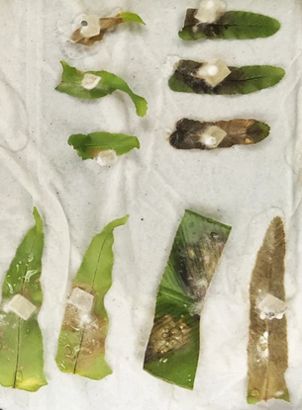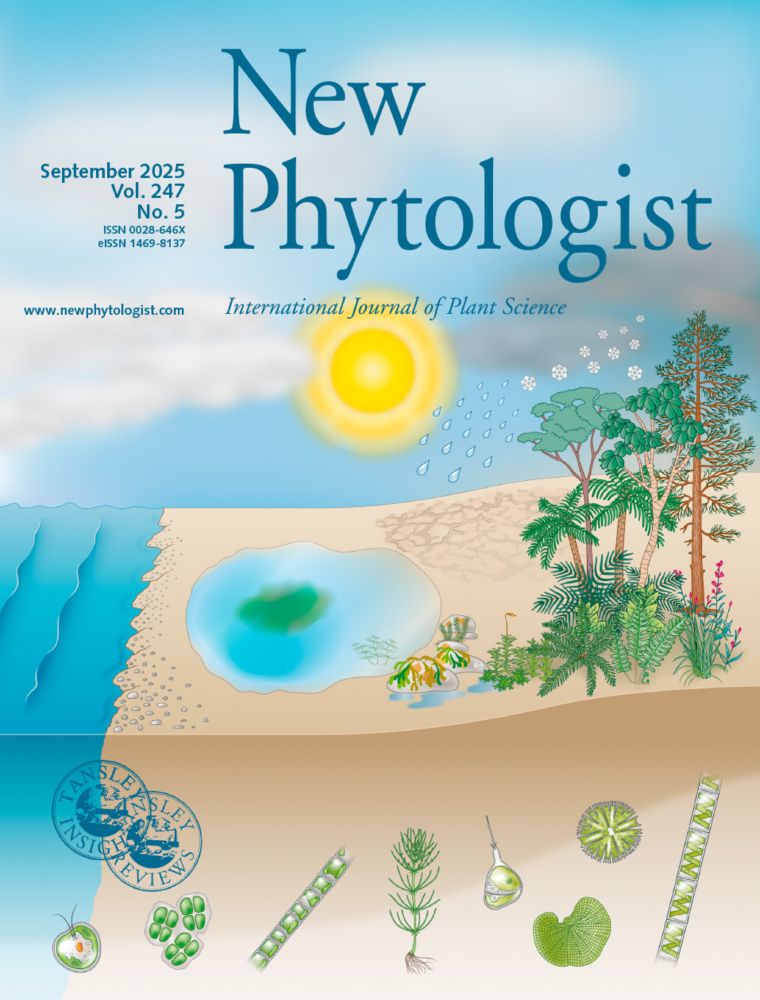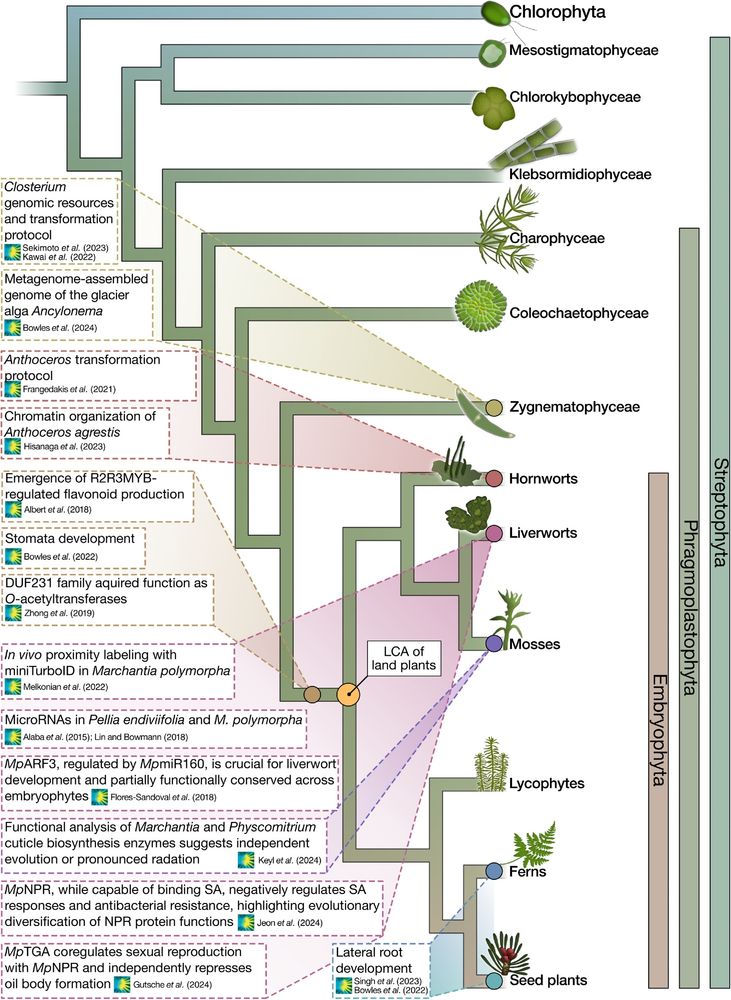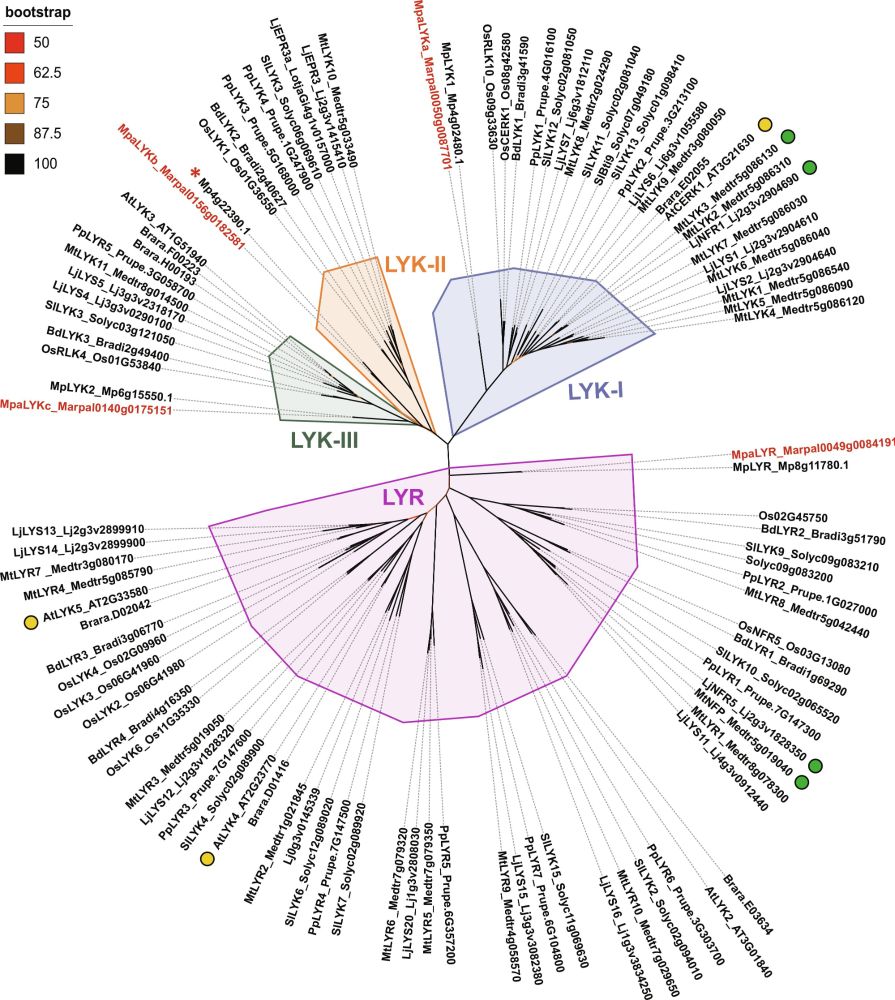
Katharina Melkonian
@katharinamel1.bsky.social
Biologist, Post-Doc at LRSV_Toulouse. PhD at mpipz_cologne. Interested in #evoMPMI #proteins #interactomics #Marchantia || Views are my own
Pinned

Symbiotic diversification relies on an ancestral gene network in plants
Symbioses have been fundamental to colonization of terrestrial ecosystems by plants and their evolution. Emergence of the ancient arbuscular mycorrhizal symbiosis was followed by the diversification o...
doi.org
1/ It is my pleasure to share the latest preprint of the team: "Symbiotic diversification relies on an ancestral gene network in plants"
doi.org/10.1101/2025...
Here, we identified and functionally validated a novel master regulator of intracellular symbioses!
A thread ...
#PlantScience
doi.org/10.1101/2025...
Here, we identified and functionally validated a novel master regulator of intracellular symbioses!
A thread ...
#PlantScience
Reposted by Katharina Melkonian
Plz RP. Come join us at @slcuplants.bsky.social @cam.ac.uk to study effector-targeted plant processes impacting plant cell biology and development.
www.cam.ac.uk/jobs/post-do...
www.schornacklab.net
www.cam.ac.uk/jobs/post-do...
www.schornacklab.net


November 6, 2025 at 6:51 PM
Plz RP. Come join us at @slcuplants.bsky.social @cam.ac.uk to study effector-targeted plant processes impacting plant cell biology and development.
www.cam.ac.uk/jobs/post-do...
www.schornacklab.net
www.cam.ac.uk/jobs/post-do...
www.schornacklab.net
Reposted by Katharina Melkonian
Outstanding preprint from @leocastanedo.bsky.social, @katharinamel1.bsky.social, @pierremarcdelaux.bsky.social and coll. on an evolutionary conserved module for intracellular symbiosis. - > Symbiotic diversification relies on an ancestral gene network in plants | bioRxiv

Symbiotic diversification relies on an ancestral gene network in plants | bioRxiv
Symbioses have been fundamental to colonization of terrestrial ecosystems by plants and their evolution. Emergence of the ancient arbuscular mycorrhizal symbiosis was followed by the diversification of alternative intracellular symbioses, such as the ericoid mycorrhizae (ErM). We aimed at understanding how these diversifications occurred. We sequenced the genomes of ErM-forming liverworts, and reconstituted symbiosis under laboratory conditions. We demonstrated the existence of a nutrient-regulated symbiotic state that enables ErM and underlies intracellular colonization of plant tissues. Comparative transcriptomic analyses identified an ancestral gene module associated with intracellular symbiosis beyond ErM. Genetic manipulations in the liverwort Marchantia paleacea, phylogenetics and transactivation assays demonstrated its essential function for intracellular symbiosis. We conclude that plant have maintained, and convergently recruited, an ancestral gene module for intracellular symbioses.
sco.lt
November 4, 2025 at 2:55 PM
Outstanding preprint from @leocastanedo.bsky.social, @katharinamel1.bsky.social, @pierremarcdelaux.bsky.social and coll. on an evolutionary conserved module for intracellular symbiosis. - > Symbiotic diversification relies on an ancestral gene network in plants | bioRxiv
Reposted by Katharina Melkonian
🛑Exciting update from our work with @pierremarcdelaux.bsky.social team on the ericoid mycorrhizal symbiosis❗❗
🔥New results support a conserved three-gene module and master regulator for nutrient-responsive intracellular accommodation of fungal symbionts🤯
Check the nice thread below👇🏼
#plantscience
🔥New results support a conserved three-gene module and master regulator for nutrient-responsive intracellular accommodation of fungal symbionts🤯
Check the nice thread below👇🏼
#plantscience
1/ It is my pleasure to share the latest preprint of the team: "Symbiotic diversification relies on an ancestral gene network in plants"
doi.org/10.1101/2025...
Here, we identified and functionally validated a novel master regulator of intracellular symbioses!
A thread ...
#PlantScience
doi.org/10.1101/2025...
Here, we identified and functionally validated a novel master regulator of intracellular symbioses!
A thread ...
#PlantScience

Symbiotic diversification relies on an ancestral gene network in plants
Symbioses have been fundamental to colonization of terrestrial ecosystems by plants and their evolution. Emergence of the ancient arbuscular mycorrhizal symbiosis was followed by the diversification o...
doi.org
November 4, 2025 at 12:30 PM
🛑Exciting update from our work with @pierremarcdelaux.bsky.social team on the ericoid mycorrhizal symbiosis❗❗
🔥New results support a conserved three-gene module and master regulator for nutrient-responsive intracellular accommodation of fungal symbionts🤯
Check the nice thread below👇🏼
#plantscience
🔥New results support a conserved three-gene module and master regulator for nutrient-responsive intracellular accommodation of fungal symbionts🤯
Check the nice thread below👇🏼
#plantscience
Reposted by Katharina Melkonian
Sooo happy to see this preprint out 🍄☘️!
Congratulations @leocastanedo.bsky.social @katharinamel1.bsky.social et al. !
It has been a long journey, from developing ericoid-mycorrhizae in the lab (Leo) to the genetics in Marchantia (Katharina), and many other details (#teamwork)
Congratulations @leocastanedo.bsky.social @katharinamel1.bsky.social et al. !
It has been a long journey, from developing ericoid-mycorrhizae in the lab (Leo) to the genetics in Marchantia (Katharina), and many other details (#teamwork)
1/ It is my pleasure to share the latest preprint of the team: "Symbiotic diversification relies on an ancestral gene network in plants"
doi.org/10.1101/2025...
Here, we identified and functionally validated a novel master regulator of intracellular symbioses!
A thread ...
#PlantScience
doi.org/10.1101/2025...
Here, we identified and functionally validated a novel master regulator of intracellular symbioses!
A thread ...
#PlantScience

Symbiotic diversification relies on an ancestral gene network in plants
Symbioses have been fundamental to colonization of terrestrial ecosystems by plants and their evolution. Emergence of the ancient arbuscular mycorrhizal symbiosis was followed by the diversification o...
doi.org
November 4, 2025 at 12:09 PM
Sooo happy to see this preprint out 🍄☘️!
Congratulations @leocastanedo.bsky.social @katharinamel1.bsky.social et al. !
It has been a long journey, from developing ericoid-mycorrhizae in the lab (Leo) to the genetics in Marchantia (Katharina), and many other details (#teamwork)
Congratulations @leocastanedo.bsky.social @katharinamel1.bsky.social et al. !
It has been a long journey, from developing ericoid-mycorrhizae in the lab (Leo) to the genetics in Marchantia (Katharina), and many other details (#teamwork)
1/ It is my pleasure to share the latest preprint of the team: "Symbiotic diversification relies on an ancestral gene network in plants"
doi.org/10.1101/2025...
Here, we identified and functionally validated a novel master regulator of intracellular symbioses!
A thread ...
#PlantScience
doi.org/10.1101/2025...
Here, we identified and functionally validated a novel master regulator of intracellular symbioses!
A thread ...
#PlantScience

Symbiotic diversification relies on an ancestral gene network in plants
Symbioses have been fundamental to colonization of terrestrial ecosystems by plants and their evolution. Emergence of the ancient arbuscular mycorrhizal symbiosis was followed by the diversification o...
doi.org
November 4, 2025 at 8:06 AM
1/ It is my pleasure to share the latest preprint of the team: "Symbiotic diversification relies on an ancestral gene network in plants"
doi.org/10.1101/2025...
Here, we identified and functionally validated a novel master regulator of intracellular symbioses!
A thread ...
#PlantScience
doi.org/10.1101/2025...
Here, we identified and functionally validated a novel master regulator of intracellular symbioses!
A thread ...
#PlantScience
Reposted by Katharina Melkonian
Postdoc position in my lab in Cologne starting early next year or latest in spring to get this exciting project started.
jobportal.uni-koeln.de/ausschreibun...
jobportal.uni-koeln.de/ausschreibun...
jobportal.uni-koeln.de
November 2, 2025 at 10:27 AM
Postdoc position in my lab in Cologne starting early next year or latest in spring to get this exciting project started.
jobportal.uni-koeln.de/ausschreibun...
jobportal.uni-koeln.de/ausschreibun...
Reposted by Katharina Melkonian
1\ bmcbiol.biomedcentral.com/articles/10....
🌿🌿Our article on fern immunity has been peer-reviewed 🌿🌿
Thanks to @madeleinebaker.bsky.social @kellerjeanphd.bsky.social @maximebonhomme.bsky.social @pierremarcdelaux.bsky.social and @jacquet-chris.bsky.social
a quick thread 🧵 1/4
🌿🌿Our article on fern immunity has been peer-reviewed 🌿🌿
Thanks to @madeleinebaker.bsky.social @kellerjeanphd.bsky.social @maximebonhomme.bsky.social @pierremarcdelaux.bsky.social and @jacquet-chris.bsky.social
a quick thread 🧵 1/4

Exploring fern pathosystems and immune receptors to bridge gaps in plant immunity - BMC Biology
Land plants include angiosperms, gymnosperms, bryophytes, lycophytes, and ferns, each of which may deploy distinct strategies to resist pathogens. Here, we investigate fern-pathogen interactions by characterizing novel pathosystems and analyzing the diversity of fern immune receptors. A collection of fern species was inoculated with a diverse set of filamentous microbes, and disease symptoms were assessed. We further leveraged published genome mining tools to analyse the diversity of receptor-like kinases, receptor-like proteins (RLKs/RLPs) and nucleotide-binding and leucine-rich repeats (NLRs), along with key immune signalling components, in ferns. Our results reveal that ferns exhibit a range of responses to pathogens, including putative non-host resistance and more specific resistance mechanisms. Among ten ferns tested, Pteris vittata displays the broadest spectrum of pathogen compatibility. Genome mining indicates that ferns encode a diverse repertoire of putative immune receptors, antimicrobial peptides, and mediators of systemic acquired resistance. Ferns possess numerous RLKs/RLPs, resembling those required for cell-surface immunity in angiosperms. They also encode diverse NLRs, including sub-families lost in flowering plants. These findings provide insights into disease resistance evolution and open promising perspectives for crop protection strategies.
bmcbiol.biomedcentral.com
October 13, 2025 at 8:28 AM
1\ bmcbiol.biomedcentral.com/articles/10....
🌿🌿Our article on fern immunity has been peer-reviewed 🌿🌿
Thanks to @madeleinebaker.bsky.social @kellerjeanphd.bsky.social @maximebonhomme.bsky.social @pierremarcdelaux.bsky.social and @jacquet-chris.bsky.social
a quick thread 🧵 1/4
🌿🌿Our article on fern immunity has been peer-reviewed 🌿🌿
Thanks to @madeleinebaker.bsky.social @kellerjeanphd.bsky.social @maximebonhomme.bsky.social @pierremarcdelaux.bsky.social and @jacquet-chris.bsky.social
a quick thread 🧵 1/4
Reposted by Katharina Melkonian
The Spirogyra genome: signatures of shared and divergent division and differentiation https://www.biorxiv.org/content/10.1101/2025.10.09.681428v1
October 11, 2025 at 2:02 AM
The Spirogyra genome: signatures of shared and divergent division and differentiation https://www.biorxiv.org/content/10.1101/2025.10.09.681428v1
Reposted by Katharina Melkonian
A first dive in fern x pathogen interaction! More to come!
Congratulations @baptistebio.bsky.social @jacquet-chris.bsky.social et al.!
Congratulations @baptistebio.bsky.social @jacquet-chris.bsky.social et al.!
Want to see ferns under attack and how they respond to pathogens? Check out our latest paper!
doi.org/10.1186/s129...
Congrats on this huge team effort to @baptistebio.bsky.social @madeleinebaker.bsky.social @kellerjeanphd.bsky.social @maximebonhomme.bsky.social @pierremarcdelaux.bsky.social
doi.org/10.1186/s129...
Congrats on this huge team effort to @baptistebio.bsky.social @madeleinebaker.bsky.social @kellerjeanphd.bsky.social @maximebonhomme.bsky.social @pierremarcdelaux.bsky.social

October 9, 2025 at 3:47 PM
A first dive in fern x pathogen interaction! More to come!
Congratulations @baptistebio.bsky.social @jacquet-chris.bsky.social et al.!
Congratulations @baptistebio.bsky.social @jacquet-chris.bsky.social et al.!
Reposted by Katharina Melkonian
~12 years after we coined it EPP1 with @oswaldovaldesl.bsky.social one afternoon when we were postdoc with @jeanmichelane.bsky.social!
Congrats @melaniekrich.bsky.social @tatiana-vernie.bsky.social et al. for the hard work!
EPP1 is the fourth member of the Common Symbiosis Pathway 🍄🌱!
Congrats @melaniekrich.bsky.social @tatiana-vernie.bsky.social et al. for the hard work!
EPP1 is the fourth member of the Common Symbiosis Pathway 🍄🌱!
So happy to see the latest preprint of the team out! www.biorxiv.org/content/10.1...
The continuation of a long standing project started by @oswaldovaldesl.bsky.social in @jeanmichelane.bsky.social‘s lab. 1/7 🧵
The continuation of a long standing project started by @oswaldovaldesl.bsky.social in @jeanmichelane.bsky.social‘s lab. 1/7 🧵

EPP1 is an ancestral component of the plant Common Symbiosis Pathway
The success of plants on land has been enabled by mutualistic intracellular associations with microbes for 450 million years ([Delaux and Schornack 2021][1]). Because of their intracellular nature, th...
www.biorxiv.org
October 6, 2025 at 3:44 PM
~12 years after we coined it EPP1 with @oswaldovaldesl.bsky.social one afternoon when we were postdoc with @jeanmichelane.bsky.social!
Congrats @melaniekrich.bsky.social @tatiana-vernie.bsky.social et al. for the hard work!
EPP1 is the fourth member of the Common Symbiosis Pathway 🍄🌱!
Congrats @melaniekrich.bsky.social @tatiana-vernie.bsky.social et al. for the hard work!
EPP1 is the fourth member of the Common Symbiosis Pathway 🍄🌱!
Reposted by Katharina Melkonian
www.biorxiv.org/content/10.1...
Great story in collaboration with @pierremarcdelaux.bsky.social and @jeanmichelane.bsky.social groups. EPP1 story continues after many years of collaborations with Pierre-Marc and Jean-Michel!!!
Great story in collaboration with @pierremarcdelaux.bsky.social and @jeanmichelane.bsky.social groups. EPP1 story continues after many years of collaborations with Pierre-Marc and Jean-Michel!!!

EPP1 is an ancestral component of the plant Common Symbiosis Pathway
The success of plants on land has been enabled by mutualistic intracellular associations with microbes for 450 million years (Delaux and Schornack 2021). Because of their intracellular nature, the est...
www.biorxiv.org
October 2, 2025 at 8:11 PM
www.biorxiv.org/content/10.1...
Great story in collaboration with @pierremarcdelaux.bsky.social and @jeanmichelane.bsky.social groups. EPP1 story continues after many years of collaborations with Pierre-Marc and Jean-Michel!!!
Great story in collaboration with @pierremarcdelaux.bsky.social and @jeanmichelane.bsky.social groups. EPP1 story continues after many years of collaborations with Pierre-Marc and Jean-Michel!!!
Reposted by Katharina Melkonian
EPP1 couples receptor activation to cytoplasmic signaling in root nodule symbiosis https://www.biorxiv.org/content/10.1101/2025.09.29.679184v1
October 1, 2025 at 11:03 PM
EPP1 couples receptor activation to cytoplasmic signaling in root nodule symbiosis https://www.biorxiv.org/content/10.1101/2025.09.29.679184v1
Reposted by Katharina Melkonian
A milestone for plant genomics just out @natgenet.nature.com
130 bryophyte genomes!
www.nature.com/articles/s41...
130 bryophyte genomes!
www.nature.com/articles/s41...

Bryophytes hold a larger gene family space than vascular plants - Nature Genetics
A super-pangenome analysis incorporating 123 newly sequenced bryophyte genomes reveals that bryophytes exhibit a larger number of unique and lineage-specific gene families than vascular plants.
www.nature.com
September 22, 2025 at 8:42 PM
A milestone for plant genomics just out @natgenet.nature.com
130 bryophyte genomes!
www.nature.com/articles/s41...
130 bryophyte genomes!
www.nature.com/articles/s41...
Reposted by Katharina Melkonian
Happy to see that 2 articles from our group led by @katharinamel1.bsky.social and David(Jeon) are highlighted.
Studies supported by @watertoland.bsky.social
Studies supported by @watertoland.bsky.social
🌿 Excited to share our new editorial on streptophyte trait evolution in the latest virtual issue from @newphyt.bsky.social, with @jandevries.bsky.social & @Ralph_Panstruga. The issue features several articles from MAdLand collaborations @watertoland.bsky.social
Check it out: doi.org/10.1111/nph....
Check it out: doi.org/10.1111/nph....


August 7, 2025 at 3:21 PM
Happy to see that 2 articles from our group led by @katharinamel1.bsky.social and David(Jeon) are highlighted.
Studies supported by @watertoland.bsky.social
Studies supported by @watertoland.bsky.social
It's TODAY! Don't miss it!
Ready for the poster session at #2025ISMPMI !
Please come chat about quantitative resistance to Aphanomyces in a new legume pathosystem ! 🌿🛡️
Thanks to @sfp-france.bsky.social for helping me be here !
P-182
Please come chat about quantitative resistance to Aphanomyces in a new legume pathosystem ! 🌿🛡️
Thanks to @sfp-france.bsky.social for helping me be here !
P-182

July 17, 2025 at 9:00 AM
It's TODAY! Don't miss it!
Nice dinner in best company #2025ISMPMI with @nicolasfreiditfrey.bsky.social @asosalop.bsky.social @yijiaaaaaa.bsky.social @mungfoo.bsky.social @hynmn-jeong.bsky.social 😊

July 14, 2025 at 6:57 PM
Nice dinner in best company #2025ISMPMI with @nicolasfreiditfrey.bsky.social @asosalop.bsky.social @yijiaaaaaa.bsky.social @mungfoo.bsky.social @hynmn-jeong.bsky.social 😊
Don't miss the talk by @nicolasfreiditfrey.bsky.social this morning, 11:40-11:50, in the concurrent session: Symbiosis and mutualism #2025ISMPMI - He will present some really cool results (yes, I am 100% biased)!
July 14, 2025 at 4:44 AM
Don't miss the talk by @nicolasfreiditfrey.bsky.social this morning, 11:40-11:50, in the concurrent session: Symbiosis and mutualism #2025ISMPMI - He will present some really cool results (yes, I am 100% biased)!
Reposted by Katharina Melkonian
@katharinamel1.bsky.social and @baptistebio.bsky.social ! I messed up with the handles in the first post..
Attending #ISMPMI2025?
Don't miss posters from our team:
▶️ @madeleinebaker.bsky.social (P-182)
▶️@baptistebio.bsky.social (P-089) and ▶️@katharinamel1.bsky.social (P-407)
▶️@nicolasfreiditfrey.bsky.social (P-425) + talk tomorrow in the Symbiosis/Mutualism session
☘️ #symbiosis #immunity #evolution
Don't miss posters from our team:
▶️ @madeleinebaker.bsky.social (P-182)
▶️@baptistebio.bsky.social (P-089) and ▶️@katharinamel1.bsky.social (P-407)
▶️@nicolasfreiditfrey.bsky.social (P-425) + talk tomorrow in the Symbiosis/Mutualism session
☘️ #symbiosis #immunity #evolution
July 13, 2025 at 6:19 PM
@katharinamel1.bsky.social and @baptistebio.bsky.social ! I messed up with the handles in the first post..
All set up for the poster session tomorrow #2025ISMPMI Please join if you wanna know more about transcription factor complexes that play roles during AMS in #MyMarchantia P-407
And, also see posters P-089 @baptistebio.bsky.social and P-182 @madeleinebaker.bsky.social
And, also see posters P-089 @baptistebio.bsky.social and P-182 @madeleinebaker.bsky.social

July 13, 2025 at 10:27 AM
All set up for the poster session tomorrow #2025ISMPMI Please join if you wanna know more about transcription factor complexes that play roles during AMS in #MyMarchantia P-407
And, also see posters P-089 @baptistebio.bsky.social and P-182 @madeleinebaker.bsky.social
And, also see posters P-089 @baptistebio.bsky.social and P-182 @madeleinebaker.bsky.social
Reposted by Katharina Melkonian
Well arrived at #2025ismpmi with @madeleinebaker.bsky.social (Poster P-182) @nicolasfreiditfrey.bsky.social (talk at symbiosis concurrent session) and @katharinamel1.bsky.social (P-407)

July 13, 2025 at 10:23 AM
Well arrived at #2025ismpmi with @madeleinebaker.bsky.social (Poster P-182) @nicolasfreiditfrey.bsky.social (talk at symbiosis concurrent session) and @katharinamel1.bsky.social (P-407)
Reposted by Katharina Melkonian
Structural basis for size-selective perception of chitin in plants https://www.biorxiv.org/content/10.1101/2025.07.09.663820v1
July 13, 2025 at 5:02 AM
Structural basis for size-selective perception of chitin in plants https://www.biorxiv.org/content/10.1101/2025.07.09.663820v1
Reposted by Katharina Melkonian
#omgn2025 @dariuskos.bsky.social presenting research on a Marchantia transcription factor which controls its reproductive structures and is stress-regulated.
Read more about it here: www.biorxiv.org/content/10.1...
Read more about it here: www.biorxiv.org/content/10.1...

July 12, 2025 at 10:34 AM
#omgn2025 @dariuskos.bsky.social presenting research on a Marchantia transcription factor which controls its reproductive structures and is stress-regulated.
Read more about it here: www.biorxiv.org/content/10.1...
Read more about it here: www.biorxiv.org/content/10.1...
On our way to Cologne 🥳 #2025ISMPMI with @nicolasfreiditfrey.bsky.social @baptistebio.bsky.social @madeleinebaker.bsky.social See you there!!!
July 12, 2025 at 6:22 AM
On our way to Cologne 🥳 #2025ISMPMI with @nicolasfreiditfrey.bsky.social @baptistebio.bsky.social @madeleinebaker.bsky.social See you there!!!
Reposted by Katharina Melkonian
Nissolia brasiliensis as a non-nodulating model legume https://www.biorxiv.org/content/10.1101/2025.07.08.663655v1
July 9, 2025 at 12:03 PM
Nissolia brasiliensis as a non-nodulating model legume https://www.biorxiv.org/content/10.1101/2025.07.08.663655v1
Reposted by Katharina Melkonian
I’m very happy that my main PhD work, under the supervision of @malick-mbengue.bsky.social, found a home in @pnas.org
Two days before my PhD defence! 🎉 (1/6)
Two days before my PhD defence! 🎉 (1/6)

A plant Lysin Motif Receptor-Like Kinase plays an ancestral function in mycorrhiza | PNAS
Arbuscular mycorrhiza (AM) with soilborne Glomeromycota fungi was pivotal in the conquest
of land by plants almost half a billion years ago. In flo...
www.pnas.org
June 12, 2025 at 8:27 AM
I’m very happy that my main PhD work, under the supervision of @malick-mbengue.bsky.social, found a home in @pnas.org
Two days before my PhD defence! 🎉 (1/6)
Two days before my PhD defence! 🎉 (1/6)

